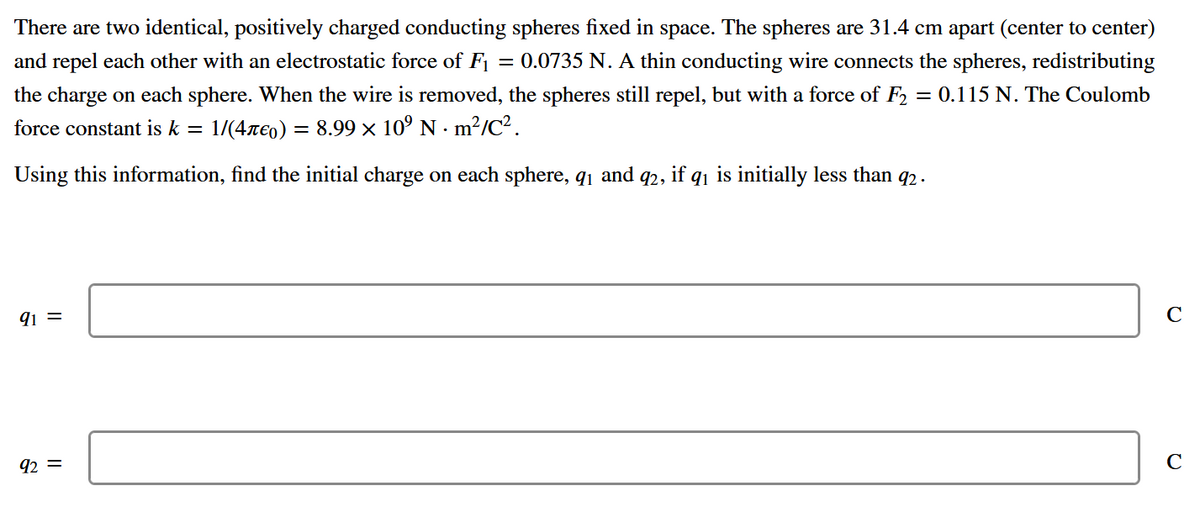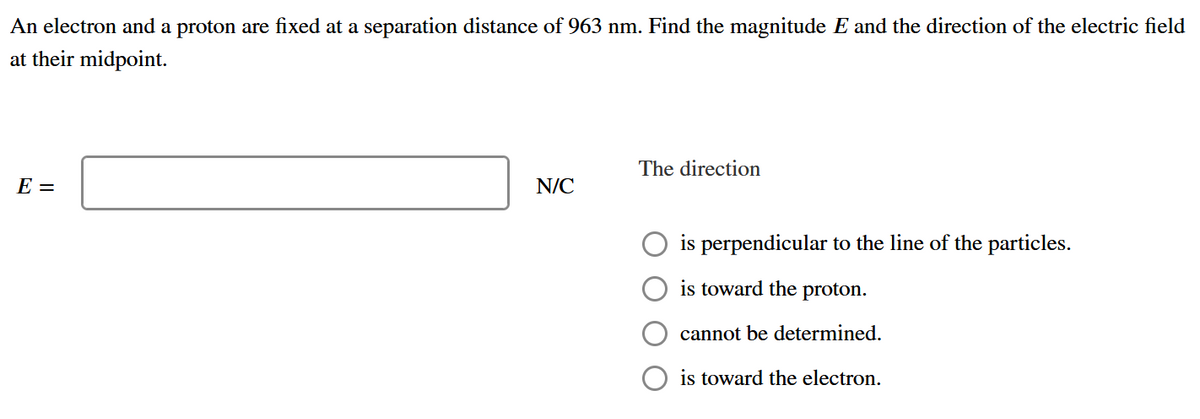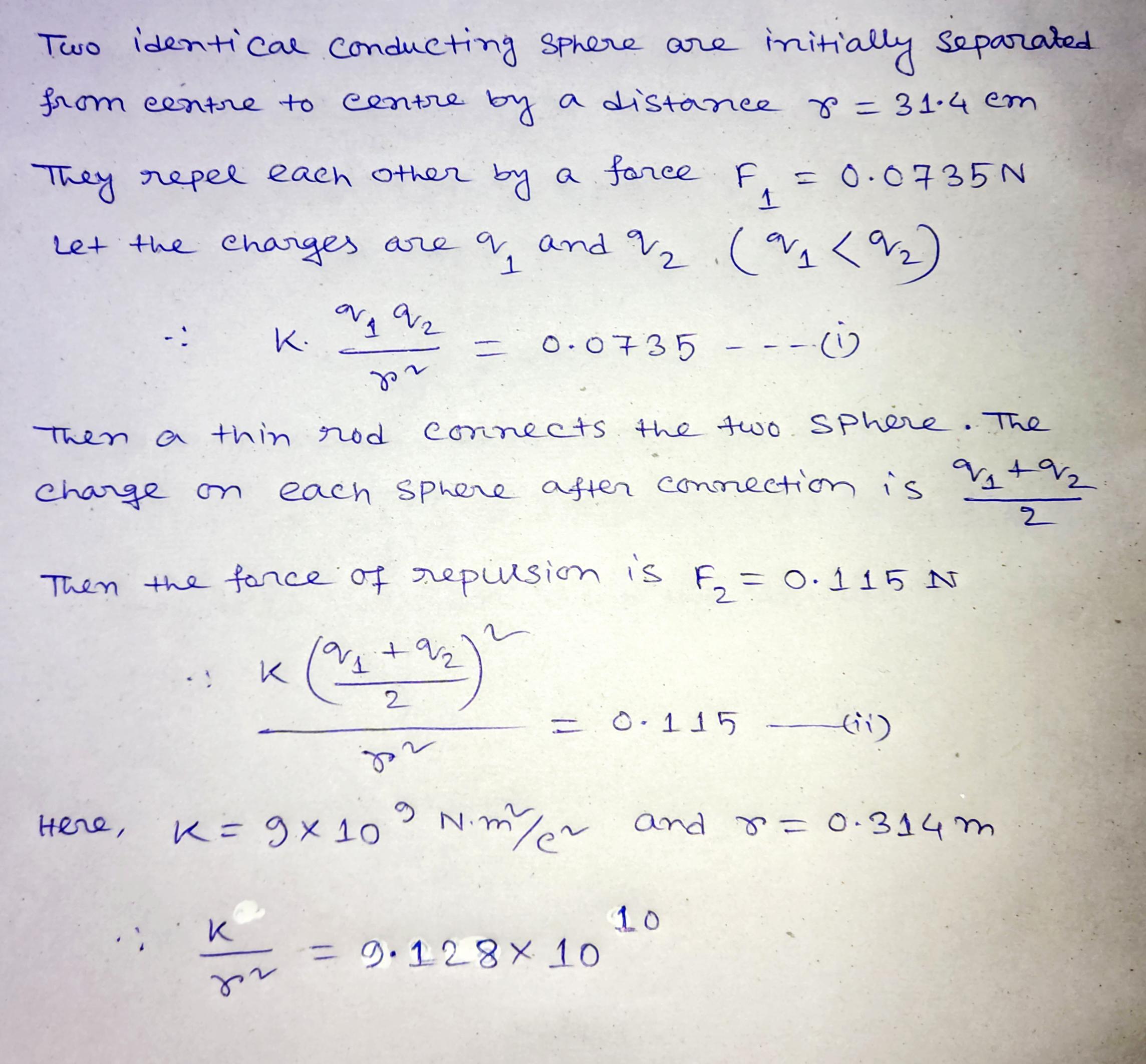There are two identical, positively charged conducting spheres fixed in space. The spheres are 31.4 cm apart (center to center) and repel each other with an electrostatic force of F = 0.0735 N. A thin conducting wire connects the spheres, redistributing the charge on each sphere. When the wire is removed, the spheres still repel, but with a force of F, = 0.115 N. The Coulomb force constant is k = 1/(4re0) = 8.99 × 10°N• m²/C². Using this information, find the initial charge on each sphere, q1 and q2, if q1 is initially less than q2. q1 = 92 = C
There are two identical, positively charged conducting spheres fixed in space. The spheres are 31.4 cm apart (center to center) and repel each other with an electrostatic force of F = 0.0735 N. A thin conducting wire connects the spheres, redistributing the charge on each sphere. When the wire is removed, the spheres still repel, but with a force of F, = 0.115 N. The Coulomb force constant is k = 1/(4re0) = 8.99 × 10°N• m²/C². Using this information, find the initial charge on each sphere, q1 and q2, if q1 is initially less than q2. q1 = 92 = C
Physics for Scientists and Engineers: Foundations and Connections
1st Edition
ISBN:9781133939146
Author:Katz, Debora M.
Publisher:Katz, Debora M.
Chapter23: Electric Forces
Section: Chapter Questions
Problem 29PQ: Two particles with charges q1 and q2 are separated by a distance d, and each exerts an electric...
Related questions
Question
these last two practice problema are killing me! please break down!

Transcribed Image Text:There are two identical, positively charged conducting spheres fixed in space. The spheres are 31.4 cm apart (center to center)
and repel each other with an electrostatic force of F1
= 0.0735 N. A thin conducting wire connects the spheres, redistributing
the charge on each sphere. When the wire is removed, the spheres still repel, but with a force of F2
= 0.115 N. The Coulomb
force constant is k =
1/(4Te0) = 8.99 × 10º N · m²/C².
Using this information, find the initial charge on each sphere, qı and
92,
if
is initially less than q2 .
91 =
C
92 =
C

Transcribed Image Text:An electron and a proton are fixed at a separation distance of 963 nm. Find the magnitude E and the direction of the electric field
at their midpoint.
The direction
E =
N/C
is perpendicular to the line of the particles.
is toward the proton.
cannot be determined.
is toward the electron.
Expert Solution
Step 1
There are two separate questions. According to guideline I solve only first one.Please post other question separately.
Trending now
This is a popular solution!
Step by step
Solved in 2 steps with 2 images

Knowledge Booster
Learn more about
Need a deep-dive on the concept behind this application? Look no further. Learn more about this topic, physics and related others by exploring similar questions and additional content below.Recommended textbooks for you

Physics for Scientists and Engineers: Foundations…
Physics
ISBN:
9781133939146
Author:
Katz, Debora M.
Publisher:
Cengage Learning

Physics for Scientists and Engineers, Technology …
Physics
ISBN:
9781305116399
Author:
Raymond A. Serway, John W. Jewett
Publisher:
Cengage Learning

Physics for Scientists and Engineers
Physics
ISBN:
9781337553278
Author:
Raymond A. Serway, John W. Jewett
Publisher:
Cengage Learning

Physics for Scientists and Engineers: Foundations…
Physics
ISBN:
9781133939146
Author:
Katz, Debora M.
Publisher:
Cengage Learning

Physics for Scientists and Engineers, Technology …
Physics
ISBN:
9781305116399
Author:
Raymond A. Serway, John W. Jewett
Publisher:
Cengage Learning

Physics for Scientists and Engineers
Physics
ISBN:
9781337553278
Author:
Raymond A. Serway, John W. Jewett
Publisher:
Cengage Learning

Physics for Scientists and Engineers with Modern …
Physics
ISBN:
9781337553292
Author:
Raymond A. Serway, John W. Jewett
Publisher:
Cengage Learning

Principles of Physics: A Calculus-Based Text
Physics
ISBN:
9781133104261
Author:
Raymond A. Serway, John W. Jewett
Publisher:
Cengage Learning

College Physics
Physics
ISBN:
9781305952300
Author:
Raymond A. Serway, Chris Vuille
Publisher:
Cengage Learning